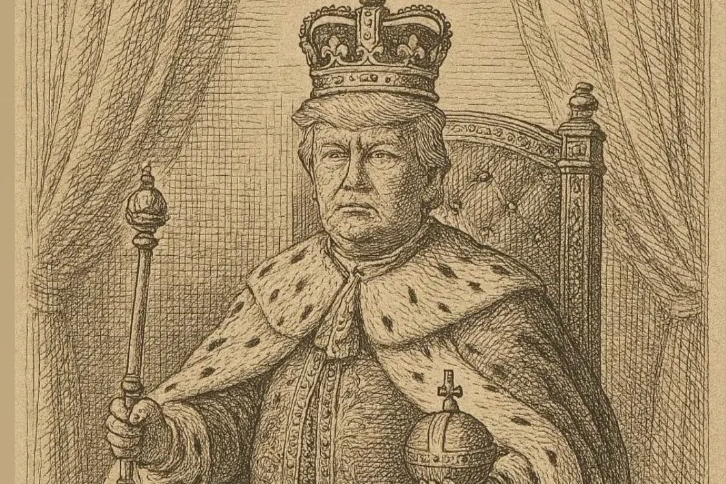The Empire City Declares It Wants No Kings As It Joins In On Massive National Protests Against Trump
Image generated by A.I.
What Are The No Kings Day Protests?
New York City once again found itself at the center of national attention this weekend as tens of thousands of residents took to the streets for the “No Kings Day” protests on October 18th, a sweeping nationwide movement denouncing former President Donald Trump and what organizers describe as his “monarchical” ambitions. Marchers across the five boroughs carried signs reading “We Want No Kings” and drew pointed parallels between Trump and King George III, invoking the country’s revolutionary roots as a rallying cry for democracy.
Donald Trump has repeatedly sought to consolidate power within the executive branch, often testing the limits of presidential authority and challenging traditional checks and balances. From pressuring federal agencies to align with his political interests to defying congressional oversight and judicial rulings, his actions have fueled concerns about an erosion of democratic norms — concerns that ultimately inspired the formation of the “No Kings” movement built on rejecting any slide toward authoritarianism in American governance.
Many protesters made a deliberate choice to leave unrelated political symbols at home, creating a unified front focused solely on resisting Donald Trump’s influence and his perceived threats to American democracy. The demonstrations were intentionally patriotic in tone — filled with American flags, copies of the Constitution, and signs invoking the nation’s founding ideals. This collective restraint reflected a broader desire to transcend individual causes and speak with one voice, signaling that the movement wasn’t about partisanship or global politics but about protecting the core democratic principles that define the United States itself.
Source: Squarespace/ Unsplash
What Is The Media Saying?
According to NPR, the event marked the second massive wave of demonstrations organized by No Kings — a network of progressive groups mobilized against Trump’s political return. Organizers reported that more than 2,600 events were planned across nearly every state, projecting an even larger turnout than their previous national action in June, which drew an estimated 5 million participants.
According to BBC News, thousands packed New York City’s iconic Times Square and surrounding streets, holding signs with slogans like “Democracy Not Monarchy” and “The Constitution Is Not Optional.” The demonstrations drew national attention not only for their massive turnout but also for their symbolism — positioning the protests as a defense of democratic principles rather than a partisan display. Ahead of the events, Trump allies sought to downplay the movement, accusing participants of being aligned with the far-left Antifa network and labeling the rallies as “hate America” rallies. Yet on the ground, the peaceful and coordinated nature of the protests in New York told a different story — one of civic unity, restraint, and an unwavering belief in the right to dissent.
Source: Squarespace/ Unsplash
What Are Authorities Saying And Doing?
In New York, protests stretched from Columbus Circle to Union Square and across boroughs including Brooklyn and Queens. Despite the sheer scale of participation, the demonstrations remained peaceful.
The NYPD confirmed on social media that “the majority of the No Kings protests have dispersed at this time and all traffic closures have been lifted,” adding that over 100,000 people joined citywide “peacefully exercising their First Amendment rights” — with zero protest-related arrests.
Having no arrests during such a large-scale mobilization underscored how seriously both citizens and law enforcement take the right to assemble. It showed that the NYPD chose to take the high road — prioritizing safety, de-escalation, and cooperation over confrontation. NYPD’s approach demonstrated a commitment to facilitating peaceful protest reinforcing New York’s role as a place where civic engagement and public expression are not just tolerated but protected.
The absence of violence and the overwhelmingly peaceful nature of the protests underscores why the NYPD is regarded as one of the finest police forces in the world, demonstrating its commitment to prioritizing public safety and the rights of New Yorkers over any form of political posturing.
In many ways, that outcome was just as powerful as the protest itself. It reminded the city — and the nation — that democracy isn’t just about disagreement or dissent; it’s also about coexistence, respect, and the ability to stand together, even in protest, without fear or violence. New York proved once again that it can channel passion into purpose — and that the defense of democracy can still be both peaceful and even as powerful as the power yielded by legislators and elected officials.
The Symbolism
The symbolism of the movement was not lost on participants or observers. By invoking imagery of the American Revolution, protesters sought to draw a direct line between 18th-century struggles for independence and contemporary fears of creeping authoritarianism. While critics dismiss such comparisons as hyperbolic, supporters argue the protests reflect a growing sentiment that democratic norms are under threat.
As the sun set on New York, chants of “No Kings” faded into the autumn air — a reminder that, for many Americans, the fight to preserve democracy remains an ongoing revolution.




